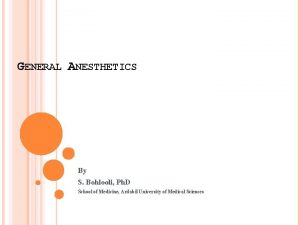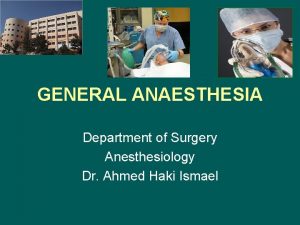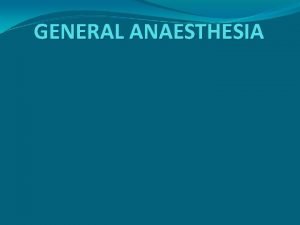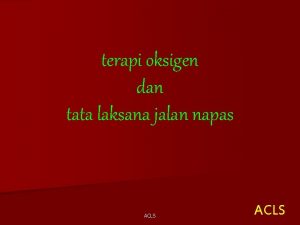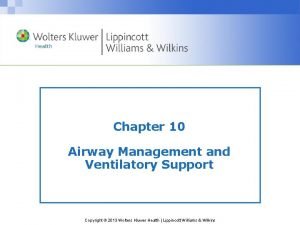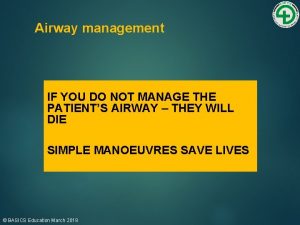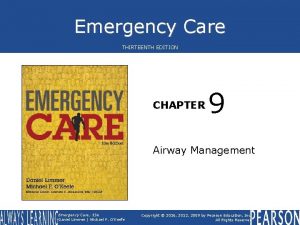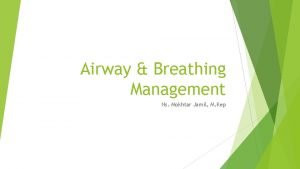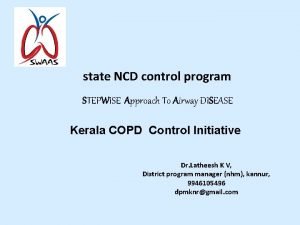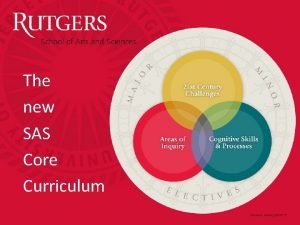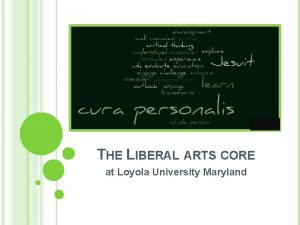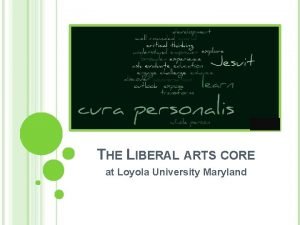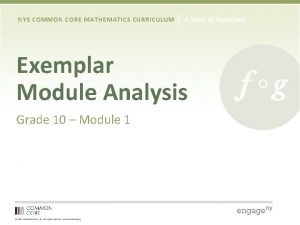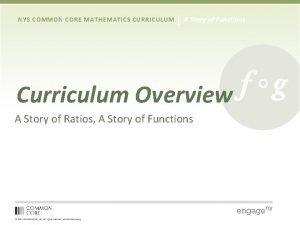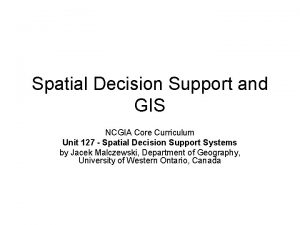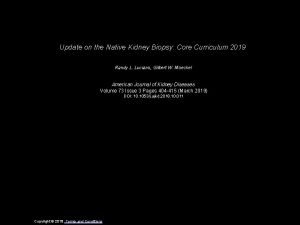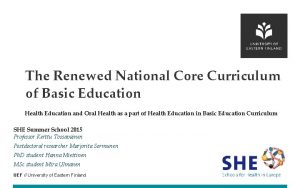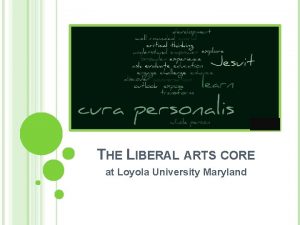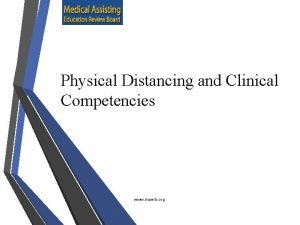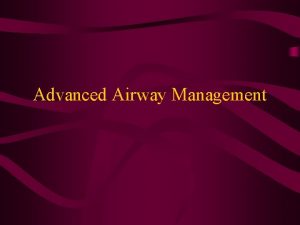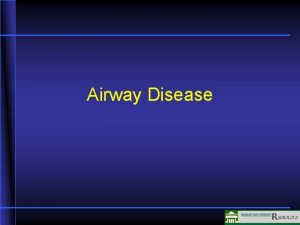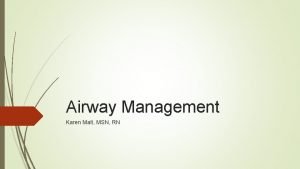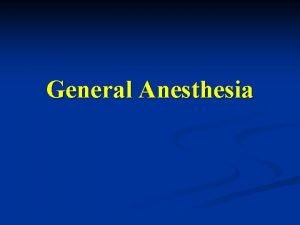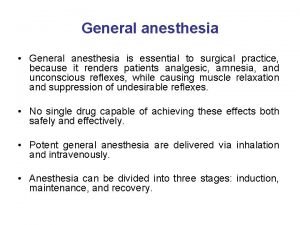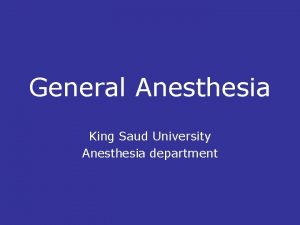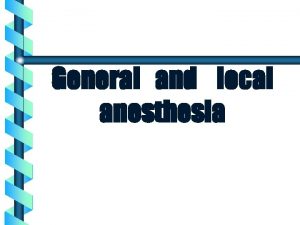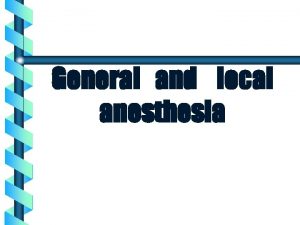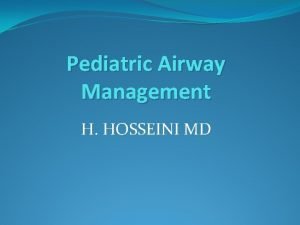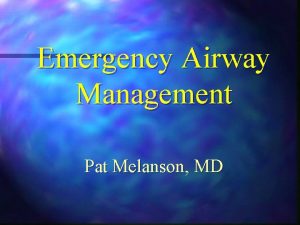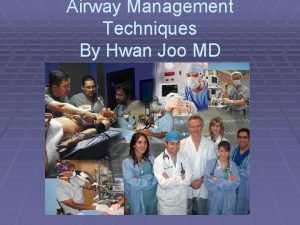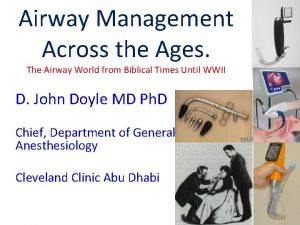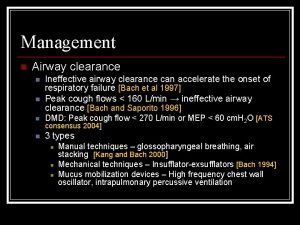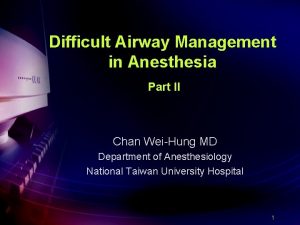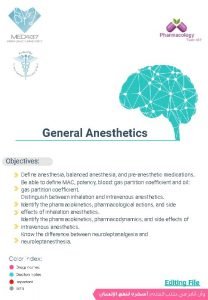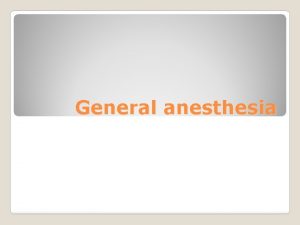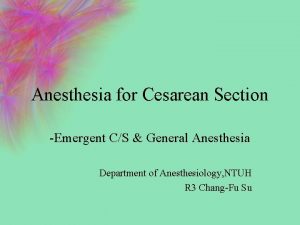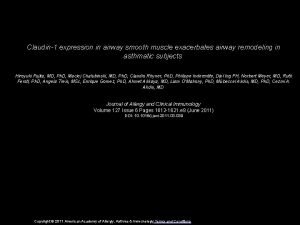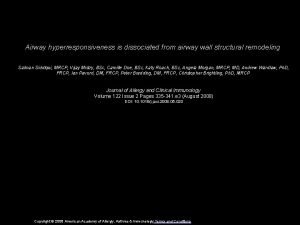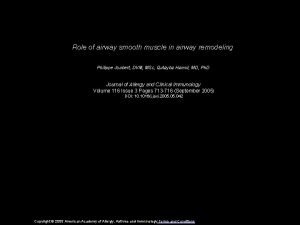Anesthesia Core Curriculum Airway Management General Anesthesia Routes



































- Slides: 35

Anesthesia Core Curriculum Airway Management

General Anesthesia Routes to secure airway: ◦ Mask ◦ LMA ◦ GETA ◦ Tracheostomy Normal O 2 saturation is 100% on room air At 92% consider O 2 assist

Overview of Anesthesia Preop Evaluation – time to ID risk factors, and minimize problems Induction – time requiring most focus and assistance Maintenance – Surgery underway, maintain and treat as necessary Emergence – time fraught with potential problems, transitional time, pain Recovery – time where the patient is arowsing from surgery and protective responses come back in place.

Standard Airway Setup Handle Blade (Mac or Miller) Oral Airway Mask and Circuit (connected and Pressure Checked) Endotracheal tube LMA

Endotracheal Tube Sizing Adult female: 6. 5 -7. 5 average Adult Male: 7. 5 – 8. 0 average Pediatric: Must follow equation of: ◦ Age/4 + 4 ◦ Cuffed is ok and actually recommended in pediatrics age 2 and older

Anatomy of the Upper Airway

Glottic Opening n. Cormack-Lehane laryngoscopy grading system n. Grade 1 & 2 low failure rates n. Grade 3 & 4 high failure rates

Glottic Opening

Mallampati Grades Class II Difficulty Class III Class IV

LMA

ALS Airway/ Ventilation Methods � Laryngeal Mask Airway (LMA) ◦ use in OR ◦ Gaining use out-ofhospital ◦ Not useful with high airway pressure ◦ Not an intubation ◦ Not replacement for endotracheal tube ◦ Multiple models, sizes ◦ Emergency airway if mask ventilation or intubation is difficult or unable to occur

Fast Track LMA Rigid in structure. Not soft like normal LMA Can be used as a general LMA Flexable ETT can be passed through Can be used as emergency airway or in difficult intubation Blind Technique 70% Successful ETT intubation

Flexible Bougie Assist in directing ETT Tube Exchanger Tracheal rings can be felt

Mc. Grath Video Laryngoscope Allows for visualization of laryngopharynx and glottic opening through video laryngoscopy Used when intubation by way of direct laryngoscopy is difficult

Fiberoptic Scope Gold Standard for Difficult Intubation Setup Not useful in bloody airways Takes great deal of skill and practice Airway must be anesthetized prior and sedation given ** Remember to have the ET Tube “loaded” onto fiberoptic scope prior to anesthesiologist placing it into the pts airway


Difficult Airway Assist Inability to visualize vocal cords with conventional laryngoscope More than 3 attempts to intubate Longer than ten minutes to intubate Locate difficult airway cart Call for extra anesthesia help Get hands on experience with airway devices before emergency arises ◦ Familiarity with devices enables us to better assist Anesthesiologist and patient.

Cricoid Pressure Recent Study showed 84% of O. R. RN’s did not know how to properly apply cricoid pressure* BURP (Backwards-Upwards. Rightward-Pressure) Amount of Pressure is Key (about 2 lbs of pressure) Do for all RSI (Rapid Sequence Induction)

Rapid Sequence Induction (RSI) Requires securing the airway in as rapid a manner as possible due to risk of aspiration or desaturation. Candidates include: Full stomachs, trauma, diabetics, GERD, obesity, bowel obstruction etc.

RSI Cont’d Steps: ◦ Appropriate premedication ◦ Appropriate positioning and monitoring ◦ Preoxygenation/ Denitrogenation ◦ Availability of airway equipment, drugs, suction ◦ A well functioning I. V. ◦ Identification of cricoid cartilage ◦ Induction agent and paralytic given in rapid sequence ◦ Cricoid pressure applied during administration of induction agent (Do not let go of cricoid pressure until ETT is placed correctly and secured!) ◦ Laryngoscopy and intubation of trachea ◦ Inflation of ETT balloon ◦ Circuit connected ◦ Test Ventilation and Et. CO 2 identification ◦ Always ask anesthesia if it is OK to release cricoid pressure ◦ AIRWAY IS SECURED!

Selection of laryngoscope blade: Miller vs. Macintosh* Miller blade is preferred for infants and younger children Facilitates lifting of the epiglottis and exposing the glottic opening Care must be taken to avoid using the blade as a fulcrum with pressure on the teeth and gums Macintosh blades are generally used in older children Blade size dependent on body mass of the patient and the preference of the Anesthesiologist

One Lung Ventilation via Double Lumen Tube

One Lung Ventilation �Primarily done for Thoracotomy and VATs �May be used in ICU to separate infected lung �Allows for ventilation of only nonsurgical lung �Challenging to place �Mac blade ideal for placement �Large diameter. Lubrication greatly improves placement ease

Double Lumen Sizing Double Lumen ETT sizing in dependant on pt size Usually female 35 -37 french Usually Male 37 french. Large Males may need 39 french if they are very tall or have long thorax

Double Lumen Placement �Direct Laryngoscopy �If pt is already intubated some attempt tube exchanger (poor success rate) � 90 degree rotation upon placement through the cords �The direction of rotation is dependant on right or left sided tube �Right sided tubes get a 90 degree right rotation and left get 90 degree left rotation


Confirmation of placement �Must have ETCO 2 present. No Exception! �Must have bilateral breath sounds �Must have chest rise �Bronchial cuff (blue port) will be inflated once tracheal intubation is confirmed �No more than 2 cc of air can ever be placed in bronchial cuff***** Inflating to touch is inappropriate

Assessing Lung Isolation After tracheal and bronchial cuffs are inflated: ◦ The tracheal port will be clamped and open to assess isolation ◦ This step is repeated with the bronchial port Isolation of the lungs must occur prior to positioning Final confirmation must be made with fiberoptic evaluation


Materials Needed for One Lung Ventilation �Double Lumen Tubes 35, 37, 39 in right and left* �Double Lumen Adaptor Port (Opti. Port) �Lumen Rubber Tipped Clamps �Mac Blades �Lubrication for fiberoptic scope and ETT �Fiberoptic Scope �CPAP bags for “down lung” �Oxygen nasal cannula and suction for

Endo Bronchial Tube (aka Dbl Lumen) Setup

Anticipating Airway Needs �OMFS: Oral and Nasal Rae and Maggils*** �Red Robin Catheter, Afrin, Lidocaine lube, Nasal Airways �Facial Plastics: Oral Rae �Thorasic Cases: Double Lumen Tube or Bronchial Blocker �Outpatient Surgery: LMA, ETT �Radical Neck Dissection: Wire reinforced tube �ENT Laser Surgery: Laser ETT �Cuffed Trachs 6. 0 and 8. 0 Shiley

Case Scenario A 44 year old 200 kg male presents for elective laparoscopic Para esophageal hiatal hernia repair for severe GERD symptoms. On preoperative airway exam, he has limited mouth opening and there is no visualization of the uvula or soft palate. He has limited neck movement and says he cannot lie flat due to his GERD. He has never had a sleep study done but he does have day time somnolence and often has morning headaches.

Case Scenario A 118 yo 52 kg male presents for laparoscopic cholecystectomy from the ED. He has an elevated WBC count and is having abdominal pain. He has a history of CHF and coronary artery disease. On airway exam, you are able to visualize part of the uvula and all of the soft palate. How would you proceed?

End Airway Module
 Laryngoscopy view grades
Laryngoscopy view grades Chin lift jaw thrust
Chin lift jaw thrust General anesthesia drugs dosage
General anesthesia drugs dosage Veterinary anesthesia reservoir bag size chart
Veterinary anesthesia reservoir bag size chart What is second gas effect
What is second gas effect Oil gas partition coefficient inhaled anesthetics
Oil gas partition coefficient inhaled anesthetics Airway management acls
Airway management acls Chapter 10 airway management
Chapter 10 airway management Supraglotal
Supraglotal Chapter 9 airway management
Chapter 9 airway management Airway abcde
Airway abcde Airway breathing management
Airway breathing management Stepwise airway management
Stepwise airway management Inner core and outer core
Inner core and outer core Mantle earth meaning
Mantle earth meaning Crust outer core inner core mantle
Crust outer core inner core mantle Core rigidity
Core rigidity Subject improvement plan
Subject improvement plan Easy sas core classes
Easy sas core classes Loyola maryland core curriculum
Loyola maryland core curriculum Chinese national curriculum core subjects
Chinese national curriculum core subjects Non statutory subjects national curriculum
Non statutory subjects national curriculum Academic worksheets loyola maryland
Academic worksheets loyola maryland Ota core curriculum
Ota core curriculum Nys common core mathematics
Nys common core mathematics Nys common core mathematics
Nys common core mathematics Iowa core curriculum
Iowa core curriculum Four components of brand positioning
Four components of brand positioning Ncgia core curriculum
Ncgia core curriculum Kidney biopsy core curriculum
Kidney biopsy core curriculum National core curriculum for basic education
National core curriculum for basic education Loyola md core requirements
Loyola md core requirements Ung core plan of study
Ung core plan of study What is core curriculum
What is core curriculum Maerb
Maerb Oklahoma core curriculum tests
Oklahoma core curriculum tests


